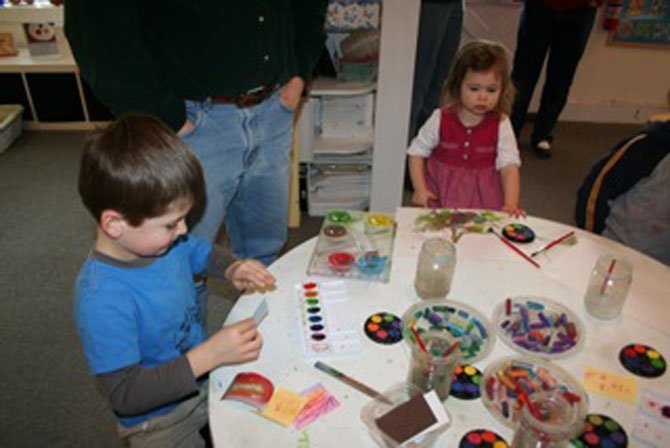Students in the Art Explorers class at Art at the Center in Mount Vernon explore mediums like clay, collage, painting and drawing. Experts say creating art helps children build relationships. Photo courtesy of Art at the Center
“Parents say it is their happy place where they can explore with their child without worrying about a mess,” said Kathryn Horn Coneway, director of Art at the Center. “It brings both parent and child into the present moment.”
In addition to having fun, art educators say that art can help children develop a myriad of skills and abilities that range from self-expression to self-confidence.
“Creating art can help them work through their emotions,” said Gioia Chilton, an art therapist who teaches art at Marymount University in Arlington. “It gives them a place where they can be confident, and where they can feel powerful and in control over something.”
Creating art teaches patience, said Coneway. “When children are working with clay, for example, there is little instant gratification. You make a piece, it has to be fired and then glazed. It is a process. But at the end, they can tell the story of how they made it.”
“Art is a universal language. Art education enables students to make creative connections with art and the world around them.”
— Carolyn Webber, art teacher, St. Andrew’s Episcopal School
Chris Haggerty, a professor of fine and applied arts at Marymount University, says research shows that art develops the right side of the brain, which affects perception rather than logic. “Creating art teaches problem-solving skills,” she said. “They get to try things out, see if they work, change their minds and start over.”
Coneway, who is also an art therapist, said she has seen first-hand how art can help children share feelings that are difficult to verbalize. “Making things is a wonderful way for kids to connect ideas, express emotions and share what is going on with them,” she said. “Additionally, art is noncompetitive. Children progress at their own rate.”
Art also helps establish a sense of community, she added. “Sometimes connections happen when children share their art,” she said. “It is neat when kids ask questions of each other. The sharing of what they make is as important as what they make.”
Carolyn Webber, an art teacher at St. Andrew’s Episcopal School in Potomac, Md., said, “Art is a universal language. Art education enables students to make creative connections with art and the world around them. [It] provides life-long learning in areas of visual arts, art history, interdisciplinary connections, multiculturalism and job opportunities.”
Haggerty said, “The most successful people are creative thinkers, people who don’t just think linearly, but who think outside of the box.”
Coneway hopes that both her classes and others establish a life-long appreciation for art. “One of the things that I hope is happening is that parents and children are leaving my classes, going home and asking, ‘Can we set up a corner our basement and have an art studio at home?’”

